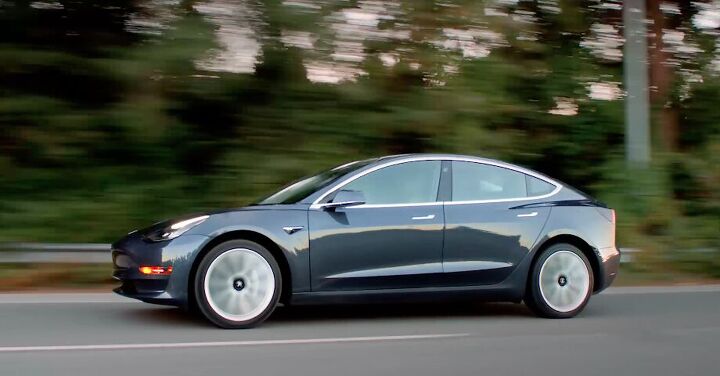Tesla Posts a Profit; Attention Returns to Company, Not Musk

For only the third time in the company’s history, Tesla reported a quarterly net profit on Wednesday, though this time the automaker says it’s back in black for good.
Third-quarter GAAP net income was $312 million, Tesla revealed, with the company’s performance fulfilling CEO Elon Musk’s earlier promise to become cash-positive by Q3 2018. The automaker’s free cash flow was $881 million for the quarter.
Give thanks to the tent.
It was expanded production of the Model 3, some of which occurs outside the company’s Fremont, California assembly plant, that pushed Tesla over the top. The company reported gross margins of 20 percent on Model 3s sold in the third quarter, a higher figure than predicted, with the number of labor hours per Model 3 falling by 30 percent between the second and third quarter of this year.
While the average production rate of Model 3s continues to fall below Musk’s promised 5,000 vehicles per week figure, throughput was great enough to bring in the desired cash. And customers paid plenty — the introduction of a pricier dual-motor Model 3 this summer was the revenue generator Musk needed. Tesla reported $6.82 billion in total revenue for the quarter. Overall, some 5,300 Model 3s finished assembly in the final week of September, the company claims.
Tesla cites “logistical challenges” in the first part of the quarter, including problems in getting vehicles to buyers’ homes, but improved door-to-door delivery allegedly solved much of that.
In an earnings call that did not spark controversy, Musk claimed the company “can actually be cash flow positive and profitable in all quarters going forward,” minus those in which a debt payment comes due. The company has no plans to raise debt or equity, he said.
What the company does plan to do is move forward with production of the Model Y, a cheaper crossover that may be targeted at the company’s planned Shanghai assembly plant, which is slated to build Model 3s. That plant is expected to start humming in late 2019. The Model Y, of which Musk says he’s approved the final prototype, won’t arrive until 2020.
While Tesla plans to build the Shanghai plant in a “capital efficient” manner, suggesting a tent-like structure similar to the one at Fremont, getting the operation off the ground will nonetheless generate a hefty bill. Some analysts question Musk’s assertion that it won’t need to take on more debt. That said, actually turning a profit makes the prospect more palatable.
Tesla’s stock shot up nearly 13 percent in after-hours trading following the release of its quarterly earnings. After the antics of the past few months, this was news investors wanted to hear.
[Source: Reuters] [Image: Tesla]

More by Steph Willems
Latest Car Reviews
Read moreLatest Product Reviews
Read moreRecent Comments
- Arthur Dailey The longest we have ever kept a car was 13 years for a Kia Rondo. Only ever had to perform routine 'wear and tear' maintenance. Brake jobs, tire replacements, fluids replacements (per mfg specs), battery replacement, etc. All in all it was an entirely positive ownership experience. The worst ownership experiences from oldest to newest were Ford, Chrysler and Hyundai.Neutral regarding GM, Honda, Nissan (two good, one not so good) and VW (3 good and 1 terrible). Experiences with other manufacturers were all too short to objectively comment on.
- MaintenanceCosts Two-speed transfer case and lockable differentials are essential for getting over the curb in Beverly Hills to park on the sidewalk.
- MaintenanceCosts I don't think any other OEM is dumb enough to market the system as "Full Self-Driving," and if it's presented as a competitor to SuperCruise or the like it's OK.
- Oberkanone Tesla license their skateboard platforms to other manufacturers. Great. Better yet, Tesla manufacture and sell the platforms and auto manufacturers manufacture the body and interiors. Fantastic.
- ToolGuy As of right now, Tesla is convinced that their old approach to FSD doesn't work, and that their new approach to FSD will work. I ain't saying I agree or disagree, just telling you where they are.


































Comments
Join the conversation
I wonder how much the soon-to-be-reduced federal tax incentive is pulling demand forward. People are trying to buy now with the full incentive instead of waiting. Just as the incentive is being phased out, competitors will be introducing competitive cars that have the full incentive. That won't be pretty.
Tesla fanboys assured us the base $35k model could be done because Tesla was setting up a fully automated production line, aka the "alien dreadnought," that would basically eliminate the need to pay human assemblers. It was reported that the highly automated line collapsed almost immediately and a humbled Musk quickly reverted to more conventional production. So the question is, without the robotized factory, is a $35k Model 3 possible? If the rumors of the Model Y being slated for assembly in China are true, is labor cost a reason why? And given that Tesla pays so-so wages, uses lots of temps, and requires mandatory overtime that literally works people sick, how big a piece of the puzzle is labor cost really? Anyone who knows about these things care to chime in? I'm wondering if a $35k model is literally impossible or not.